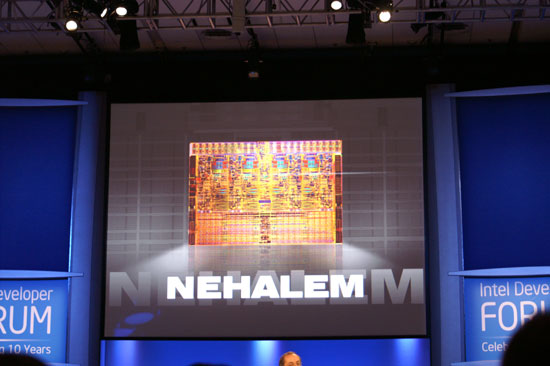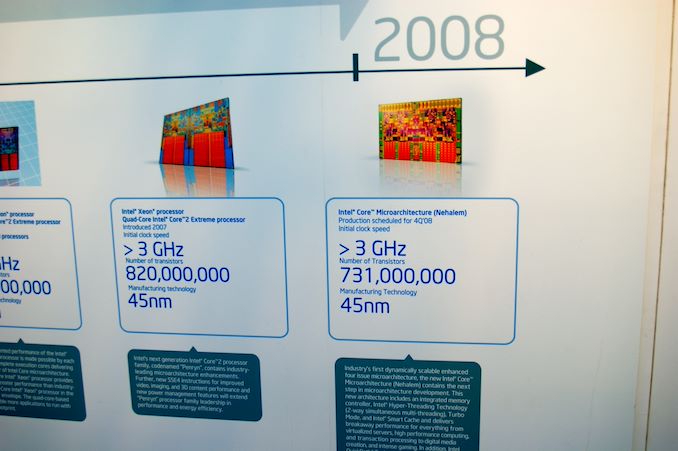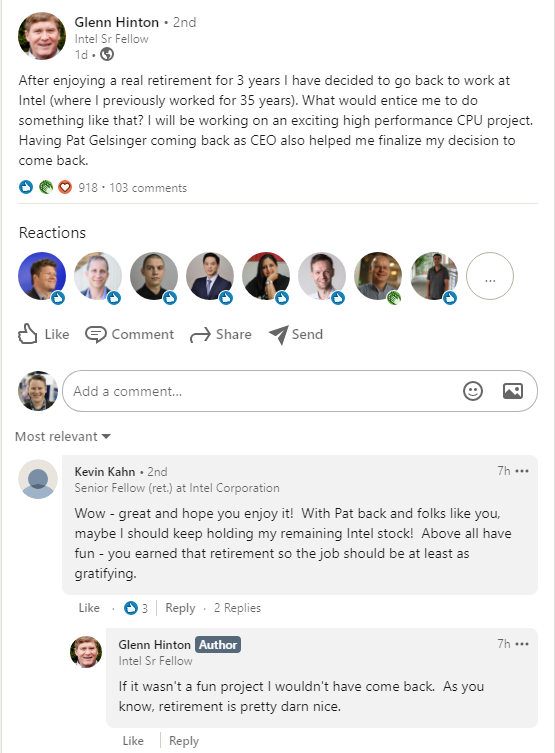New Intel CEO Making Waves: Rehiring Retired CPU Architects
by Dr. Ian Cutress on January 21, 2021 5:05 AM EST- Posted in
- CPUs
- Intel
- Nehalem
- Pat Gelsinger

We’re following the state of play with Intel’s new CEO, Pat Gelsinger, very closely. Even as an Intel employee for 30 years, rising to the rank of CTO, then taking 12 years away from the company, his arrival has been met with praise across the spectrum given his background and previous successes. He isn’t even set to take his new role until February 15th, however his return is already causing a stir with Intel’s current R&D teams.
News in the last 24 hours, based on public statements, states that former Intel Senior Fellow Glenn Hinton, who lists being the lead architect of Intel’s Nehalem CPU core in his list of achievements, is coming out of retirement to re-join the company. (The other lead architect of Nehalem are Ronak Singhal and Per Hammerlund - Ronak is still at Intel, working on next-gen processors, while Per has been at Apple for five years.)
Hinton is an old Intel hand, with 35 years of experience, leading microarchitecture development of Pentium 4, one of three senior architects of Intel’s P6 processor design (which led to Pentium Pro, P2, P3), and ultimately one of the drivers to Intel’s Core architecture which is still at the forefront of Intel’s portfolio today. He also a lead microarchitect for Intel’s i960 CA, the world’s first super-scalar microprocessor. Hinton holds more than 90+ patents from 8 CPU designs from his endeavors. Hinton spent another 10+ years at Intel after Nehalem, but Nehalem is listed in many places as his primary public achievement at Intel.
On his social media posts, Hinton states that he will be working on ‘an exciting high performance CPU project’. In the associated comments also states that ‘if it wasn’t a fun project I wouldn’t have come back – as you know, retirement is pretty darn nice’. Glenn also discloses that he has been pondering the move since November, and Gelsinger’s re-hiring helped finalize that decision. His peers also opine that Glenn is probably not the only ex-Intel architect that might be heading back to the company. We know a few architects and specialists that have left Intel in recent years to join Intel's competitors, such as AMD and Apple.
There are a few key things to note here worth considering.
First is that coming out of retirement for a big CPU project isn’t a trivial thing, especially for an Intel Senior Fellow. Given Intel’s successes, one would assume that the financial situation is not the main driver here, but the opportunity to work on something new and exciting. Plus, these sorts of projects take years of development, at least three, and thus Glenn is signing on for a long term despite already having left to retire.
Second point is reiterating that last line – whatever project Glenn is working on, it will be a long term project. Assuming that Glenn is talking about a fresh project within Intel’s R&D ecosystem, it will be 3-5 years before we see the fruits of the labor, which also means creating a design aimed at what could be a variety of process node technologies. Glenn’s expertise as lead architect is quite likely applicable for any stage of an Intel R&D design window, but is perhaps best served from the initial stages. The way Glenn seems to put it, this might be a black-ops style design. It also doesn't specify if this is x86, leaving that door open to speculation.
Third here is to recognize that Intel has a number of processor design teams in-house and despite the manufacturing process delays, they haven’t been idle. We’ve been seeing refresh after refresh of Skylake lead Intel's portfolio, and while the first iterations of the 10nm Cove cores come to market, Intel’s internal design teams would have been working on the next generation, and the next generation after that – the only barrier to deployment would have been manufacturing. I recall a discussion with Intel’s engineers around Kaby Lake time, when I asked about Intel’s progress on IPC – I requested a +10% gen-on-gen increase over the next two years at the time, and I was told that those designs were done and baked – they were already working on the ones beyond that. Those designs were likely Ice/Tiger Lake, and so Intel’s core design teams have been surging ahead despite manufacturing issues, and I wonder if there’s now a 3-4 year (or more) delay on some of these designs. If Glenn is hinting at a project beyond that, then we could be waiting even longer.
Fourth and finally, one of the critical elements listed by a number of analysts on the announcement of Gelsinger’s arrival was that he wouldn’t have much of an effect until 3+ years down the line, because of how product cycles work. I rejected that premise outright, stating that Pat can come in and change elements of Intel’s culture immediately, and could sit in the room with the relevant engineers and discuss product design on a level that Bob Swan cannot. Pat has the opportunity to arrange the leadership structure and instill new confidence in those structures, some of which may have caused key architects in the past to retire, instead of build on exciting projects.
As we can see, Pat is already having an effect before his name is even on the door at HQ.
Today is also Intel’s end-of-year financial disclosure, at 5pm ET. We are expecting Intel’s current CEO, Bob Swan, to talk through what looks to be another record breaking year of revenue, and likely the state of play for Intel's own 7nm process node technologies. That last point is somewhat thrown into doubt given the new CEO announcement and if Gelsinger is on the call. It is unknown if Gelsinger will participate.
Related Reading
- Intel Appoints Pat Gelsinger as New CEO, From Feb 15th
- An Interview with Intel CEO Bob Swan: Roundtable Q&A on Fabs and Future
- Robert Swan Named CEO of Intel













112 Comments
View All Comments
mode_13h - Saturday, January 23, 2021 - link
Assuming they're eventually going to get beyond x86, why do you care what it is? IA64's biggest problems were that it was never out-of-order (though it could've been) and never got imbued with SIMD instructions. Those are both fixable problems and IA64 probably has the broadest software support after ARM, so it makes a lot of sense.I think that by moving data-dependency analysis out of the hardware, IA64 has a real chance to be more efficient and perhaps even faster than ARM or RISC-V. It just needs a proper implementation, which Intel never did. They burned their entire transistor budget on making it as wide as possible, and by the time they could possibly revisit the decision not to go out-of-order, management had already lost interest.
Burning Up - Thursday, January 21, 2021 - link
Intel is in serious trouble and decline and these hires will not change it. RISC and ARM is the future and not x86.grant3 - Thursday, January 21, 2021 - link
I see a lot of comments like these, worshipping RISC as if it's automagically the ideal ISA philosophy for all situations. This despite decades of research have conclusively proven.... "it depends."ARM is great, ARM is popular, but it's only 'the future' until another superior approach is validated.
Lord of the Bored - Friday, January 22, 2021 - link
RISC has been the future that is dooming x86 for what, forty years now?RanFodar - Friday, January 22, 2021 - link
They can do it, unless Intel has something up in their sleeves. I'm sure they have one.JayNor - Friday, January 22, 2021 - link
The Gracemont cores in Alder Lake appear to be a reply to the small ARM cores in the M1.I've read that the x86 decode is all that is comparatively larger than the RISC architectures. From decode it creates effectively RISC like instructions now ... supposedly been this way for many years, so RISC vs CISC arguments have mostly disappeared.
lmcd - Saturday, January 23, 2021 - link
The Gracemont cores in Alder Lake have likely been planned for 4-5 years.GeoffreyA - Sunday, January 24, 2021 - link
Agreed. The main weakness is x86 instructions being variable-length, which make parallel decoding difficult. ARM being fixed-length makes that part easier. My view is that x86 CPUs are the perfect blend of CISC and RISC, at least in their popular senses. Even ARM is getting more complicated over time.IUU - Saturday, January 23, 2021 - link
Everyone is discussing about architectures, which are inportant, I have no doubt about this.But let's remember a bit about Intel history for the past 15 years.
Intel went from 65nm based cpus around 2006-2007 to 45nm
and then to 32nm and 22 nm by 2011!
Then , it supposedly had diffciculties at 14nm, and it took 3 years
to half-launch cpus at 14nm!
Then it had more diffculties advancing further and untill today
you need to be lucky to find products at 10nm. Full 7 years after
launching 14nm cpus they are not able to effectively mass produce
chips at 10!
As a parenthesis , people please remember that Paul Otellini was CEO
until 2013.
Normally , one would accept manufacturing difficulties with good will , if not
with some scepticism too.
Imo Intel's downfall began right after launching Ivy bridge at 22nm. There
was a fab to be made for the new 14nm innovative process that cost 5 billions
and there was a change in CEOs.
Seeing however how Intel's competitors, which were behind Intel at 2011, managed to reach
and surpass Intel through all these years , goes to show that manufacturing difficulties
were not insurmountable. And if it were someone to win this should be Intel, while at its peak
and all the talent and money under its umbrella.
Being held back so many years in the manufacturing field was the main reason
why Intel eventually lost the ball. I mean , how on earth is it possible to still not be
able to master 10 nm which is capable of 100 mtr/mm2 , while TSMC managed to offer 5nm
products with a transistor density of 170 mtr/mm2?
And TSMC and maybe Samsung are ready to get to the next phase to even smaller
nodes. Intel on the other side , seemingly is only able to announce new nodes and architectures
only to delay them a few months later.
It is very probable Intel has been facing huge internal organsational and administrative problems through all these years , that no-one dares to admit. Because , to make an analogy with soccer, it had the best goalkeeper facing a penalty , only with the goalkeeper to step aside and do nothing while the opponent player was executing the kick. It scored against its team while at its peak . How this happened is up to Intel to search and find its internal affairs. This much is obvious. It is the details that need to be clarified.
Architecture is good and all, but if it is so important why did not Apple choose 14 or 22 nm to make its silicon? Food for thought.
JoeDuarte - Tuesday, January 26, 2021 - link
Speaking of departed CPU architects, why did Jim Keller leave? Will Intel try to bring him back? From all his sudden departures and job changes, I got the impression he might be high maintenance and not someone who can be counted on to actually stick around in any job, but Reuters said: "In June, it lost one of its veteran chip designers, Jim Keller, over a dispute on whether the company should outsource more of its production, sources said at the time."I don't know if that means he was in favor of outsourcing more production, or opposed to it, or why either situation would cause him to leave... (https://www.reuters.com/article/us-intel-thirdpoin...